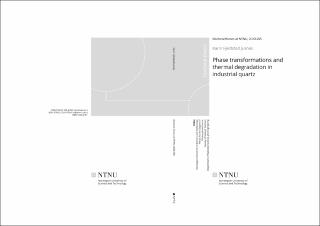| dc.description.abstract | Quartz is used as the silicon source for silicon and ferrosilicon production. Together with various carbon materials, the quartz is added to a submerged arc furnace. Energy is supplied through three carbon electrodes, which heat the raw materials to above 2000 °C. Silicon and ferrosilicon has a wide variety of use. The purest silicon is used in photovoltaic and electronic industry, while the less pure is used as an alloying element in aluminum and is the starting material for chemical processing of silicones used in cosmetics, paint, coatings, medical equipment etc. Ferrosilicon is used in steel industry to remove oxygen and increase properties as strength, wear resistance and elasticity. Worldwide, Norway is one of the largest producers of silicon and ferrosilicon.
The behavior of quartz at high temperature is important to know because it affects the furnace operation. Important properties such as fines generation (and also lump size), phase transformations and impurity content will determine how suitable a quartz type is for the production of silicon or ferrosilicon. If the fines generation is high, more fines will be created in the furnace and decrease the permeability, i.e. the flow of raw materials downwards, and gases upwards. Different high temperature polymorphs of silica will be created in a furnace. These could affect the reaction rates, and also decrease the permeability since a theoretical volume increase of 17 % follows the phase transformation from quartz to cristobalite.
In this thesis, the thermal degradation and the phase transformations are investigated in quartz types used in Si or FeSi production. By shock heating quartz samples to 1500 °C, the degree of disintegration was determined and the quartz types were compared with each other. The amount of fines below 10 mm varied from around 5 wt% up to 85 wt% for different quartz types. Enhancing properties were investigated, and a correlation was seen between the degree of disintegration and larger grain size and preexisting cracks in the samples. A negative correlation was observed between the amount of muscovite (KAl2(Si3AlO10)(OH)2) and the amount of fines below 10 mm.
The phase transformations from quartz to cristobalite via amorphous intermediate state have also been investigated in different quartz types. The ability to transform into other silica polymorphs at 1600 °C and 1700 °C vary from one quartz type to another. Properties which had an enhancing effect on the ability to transform were preexisting cracks, alkali and alkali earth impurities and possibly other lattice defects such as solid and fluid inclusions which could serve as nucleation point for the amorphous intermediate phase. The mechanism of the phase transformation was found to be a nucleation mechanism. This statement is supported by the missing observation of any size effect when investigating the phase transformations.
Knowledge of the high temperature behavior of quartz, would be very beneficial for the industry when selecting new quartz types to use. A deeper understanding of the relationship between quartz properties and the behavior of quartz would lead to a more efficient furnace operation, better understanding of the process and improved raw material selection for the desired product. | en_US |
